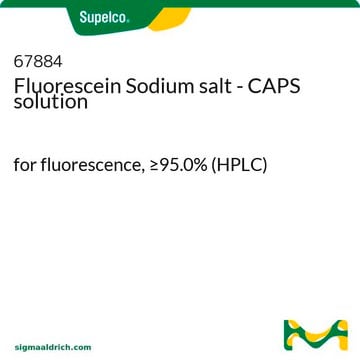46970
Fluorescein sodium salt
p.a., for source staining
Sinónimos:
Acid Yellow 73, D&C;Yellow No. 8, NaFl, NaFluo, Sodium fluorescein, Uranine
About This Item
Productos recomendados
grado
for source staining
p.a.
Nivel de calidad
formulario
powder
fluorescencia
λex 460 nm; λem 515 nm(lit.)
cadena SMILES
[Na+].[Na+].[O-]c1ccc2c(Oc3cc([O-])ccc3C24OC(=O)c5ccccc45)c1
InChI
1S/C20H12O5.2Na/c21-11-5-7-15-17(9-11)24-18-10-12(22)6-8-16(18)20(15)14-4-2-1-3-13(14)19(23)25-20;;/h1-10,21-22H;;/q;2*+1/p-2
Clave InChI
RGPLGPBQJOQFJS-UHFFFAOYSA-L
¿Está buscando productos similares? Visita Guía de comparación de productos
Categorías relacionadas
Descripción general
Aplicación
Xanthene fluorophores, like Fluorescein Sodium Salt (FSS), are versatile compounds used across diverse fields of chemistry and life sciences.
Código de clase de almacenamiento
11 - Combustible Solids
Clase de riesgo para el agua (WGK)
WGK 1
Punto de inflamabilidad (°F)
423.7 °F - Pensky-Martens closed cup
Punto de inflamabilidad (°C)
217.6 °C - Pensky-Martens closed cup
Equipo de protección personal
Eyeshields, Gloves, type N95 (US)
Certificados de análisis (COA)
Busque Certificados de análisis (COA) introduciendo el número de lote del producto. Los números de lote se encuentran en la etiqueta del producto después de las palabras «Lot» o «Batch»
¿Ya tiene este producto?
Encuentre la documentación para los productos que ha comprado recientemente en la Biblioteca de documentos.
Los clientes también vieron
Nuestro equipo de científicos tiene experiencia en todas las áreas de investigación: Ciencias de la vida, Ciencia de los materiales, Síntesis química, Cromatografía, Analítica y muchas otras.
Póngase en contacto con el Servicio técnico





![6-[Fluorescein-5(6)-carboxamido]hexanoic acid suitable for fluorescence, ≥90% (HPCE)](/deepweb/assets/sigmaaldrich/product/structures/348/284/a1850c0d-b6b1-49e3-b058-5ba79967e9e5/640/a1850c0d-b6b1-49e3-b058-5ba79967e9e5.png)

